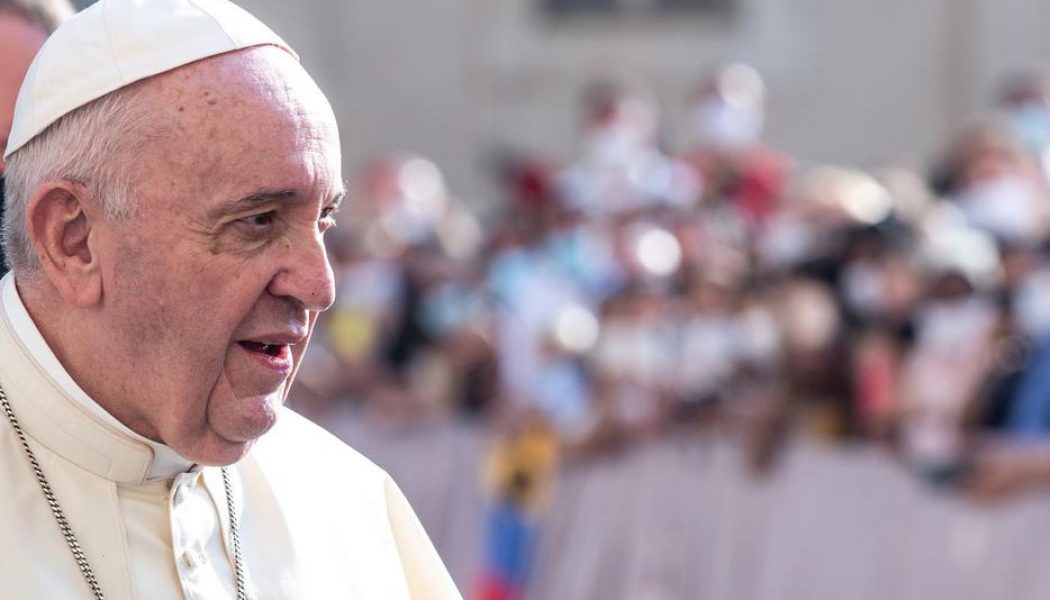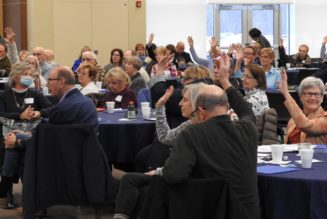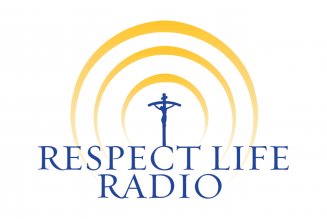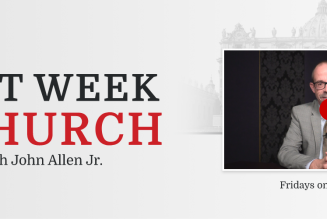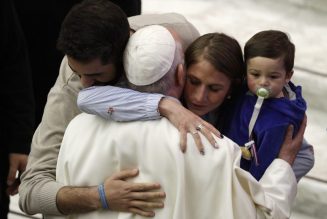
The global headlines reporting that Pope Francis is in favor of civil unions for same-sex couples presented the Holy Father’s comments as a dramatic shift in the Catholic Church’s teaching on homosexual relationships. There is less here than meets the eye, but it remains a significant statement.
What exactly it means remains unclear. The Holy Father’s brief comments — a few sentences — in a documentary film released Oct. 21 were not part of a carefully drafted address, let alone a formal teaching document. The comments are of the same weight and character of the airborne press conferences that Pope Francis has not had the opportunity to conduct this pandemic year. Perhaps this film was embraced as an opportunity to scratch that garrulous itch.
But there has been discussion that improper editing of the Pope’s statements has led to much of the confusion.
There is something of an “imbergoglio” about all this.
A modestly competent Vatican communications operation ought to have previewed the documentary and prepared explanatory background materials to help viewers understand what the Holy Father was doing — and what he was not doing.
What Pope Francis Did
It has been a hallmark of the Francis pontificate that he draws close to those on the “peripheries,” to the suffering and the wounded. Indeed, it is one of the most attractive aspects of his witness and ministry. Whether the “gay rights” movement is on the peripheries is debatable, but that there are those in the “LGBT” community who feel excluded, even ostracized, from the life of the Church is a pastoral reality that the Holy Father has sought to address. His initial comment is entirely consistent with many of his previous statements and actions:
“Homosexual people have the right to be in a family. They are children of God. You can’t kick someone out of a family, nor make their life miserable for this.”
It should be noted that the use of the “LGBT” acronym in many news stories and commentaries is, in this case, wildly inaccurate. The Holy Father spoke of “homosexual people” (LGB) and not “trans” (T) people; to the contrary, Pope Francis is perhaps the world leader most vociferously opposed to what he frequently denounces as “gender ideology.”
The second part of the Holy Father’s comment dealt with legal arrangements for same-sex couples:
“What we have to create is a civil union law; that way they are legally covered.”
As has been well documented in biographies of Pope Francis, in 2010 as archbishop of Buenos Aires he fought against same-sex “marriage” but advocated for “civil unions” or some legal protections for same-sex couples.
The distinction he made at the time was that only marriage is marriage — meaning a man and a woman — but that individuals in other relationships might be afforded protections of law.
That the Holy Father said that “we have to create” has been interpreted by some as kind of pontifical mandate, but that is too much weight to put upon a passing comment. In any case, the civil-union horse has long since left the barn, so it remains unclear what situations the Holy Father had in mind. In much of the world, civil unions would be seen as a step backward for same-sex rights; in other parts of the world it is dismissed as a distraction from the prize of same-sex “marriage.”
It is odd, but true, that the declaration of Pope Francis is almost entirely irrelevant to the world. It remains relevant to the Church (see below). Given that he referred to his position in 2010 — “I stood up for that” — it is entirely possible that he was offering an explanatory comment on recent history.
What Pope Francis Did Not Do
The Holy Father did not change Church teaching on the nature of marriage, nor did he suggest that other arrangements could make same-sex relationships equivalent to marriage.
“His comments in no way signal a departure from the teaching of the Catholic Church concerning marriage or homosexuality,” said Bishop David Zubik of Pittsburgh. “It speaks, rather, of a pastoral approach to these issues.”
Bishop Zubik noted that the papal exhortation Amoris Laetitia (2016) invites compassion for homosexual people and their families (250). That same document also teaches that “there are absolutely no grounds for considering homosexual unions to be in any way similar or even remotely analogous to God’s plan for marriage and family” (251).
In saying that “homosexual people” have a “right” to be “in a family” or “part of family” (depending upon the translation) it does not seem that Pope Francis is speaking about complex legal matters like IVF or adoption. He is likely referring to families of origin and that homosexual people should not be driven out or deprived of the love of their parents, siblings and relatives. If the Holy Father had more than that in mind, he would have said so; he is repeating here what he taught in Amoris Laetitia.
The San Francisco Solution
In 1997, the city of San Francisco mandated that employers — including the Catholic Church — provide benefits to same-sex couples. Archbishop William Levada — the future Congregation for the Doctrine of the Faith prefect under Benedict XVI — proposed a different solution. An employee could designate another person at the same address to share in the benefits. That would satisfy the city’s demands that same-sex couples in a sexual relationship would have benefits, but also did not involve the Church in a formal recognition of such relationships as equivalent to marriage. (The same logic would apply to common-law relationships.)
The San Francisco solution would permit an employee to designate a sibling, an elderly parent or an adult child, and so arguments were made that it was a pro-family policy in effect, even if had not originated as such.
The current archbishop of San Francisco, Salvatore Cordileone, issued a statement on the Holy Father’s remarks that put “civil unions” in the context of the San Francisco solution:
“I would add that a civil union of this type (one which is not equated to marriage) should be as inclusive as possible, and not be restricted to two people of the same sex in a presumed sexual relationship. There is no reason, for example, why a brother and a sister, both of whom are unmarried and support each other, should not have access to these kinds of benefits. Marriage is unique because it is the only institution that connects children to their mothers and fathers, and therefore is presumed to be a sexual relationship.”
Fake Marriage
In 2017, columnist Michael Sean Winters of the National Catholic Reporter, a self-styled liberal Catholic sympathetic to same-sex “marriage,” sketched out a scenario in which he would enter a (fake) same-sex “marriage”:
“If I found out tomorrow I had cancer and only had six months to live, I would marry my former roommate, who is also a male. I would not do so because we are lovers, as we are not. I would not do so because I intended by that action to approximate in anyway the sacrament of marriage the church bestows. No, I would do so because, having been the executor of my dad’s relatively small and simple estate, I know it would be much, much easier to deal with things like my bank accounts and, most especially, my dog if I had a legal spouse who lived on after me.”
Winters is not discussing a homosexual relationship, but the legal and logistical issues are similar. A “civil union” permits other relationships — including but not limited to same-sex sexual relationships — to address such matters. Depending on how drafted, such provisions would obviate the need for Winters and other like him to opt for a fake marriage, but enjoy legal protections.
Father James Martin
Jesuit Father James Martin explains why he regards the Holy Father’s comments as “momentous”:
“First, he is saying them as Pope, not as Archbishop of Buenos Aires. Second, Francis is very clearly supporting, not simply tolerating, civil unions. Third, he is saying it on camera, in a new documentary, not privately. (I’ve seen the film and the filmmaker wisely shows him saying this on camera, not as a voiceover.)
“This is an historic step forward for the church in its relationship with LGBTQ people, and LGBTQ Catholics.”
Father Martin is to the pontificate of Pope Francis as Father Robert Barron was for Benedict XVI or Father Richard John Neuhaus was for St. John Paul II — the privileged American sacerdotal interpreter. He captures in a particular way the intent, or flavor, of what the Holy Father wishes to do, and attention ought to be paid. Father Martin is granted considerable attention by media outlets who regard him as a champion of changing Catholic teaching on homosexuality.
And so while there is less here than meets the eye, it is not insignificant. And significance is not determined only by parsing syntax, but how things are received.
After all, the signature phrase of the entire ministry of Pope Francis — his version of John Paul’s “Be not afraid!” — was a similar extemporaneous comment about homosexual people: “Who am I to judge?”
Join Our Telegram Group : Salvation & Prosperity
